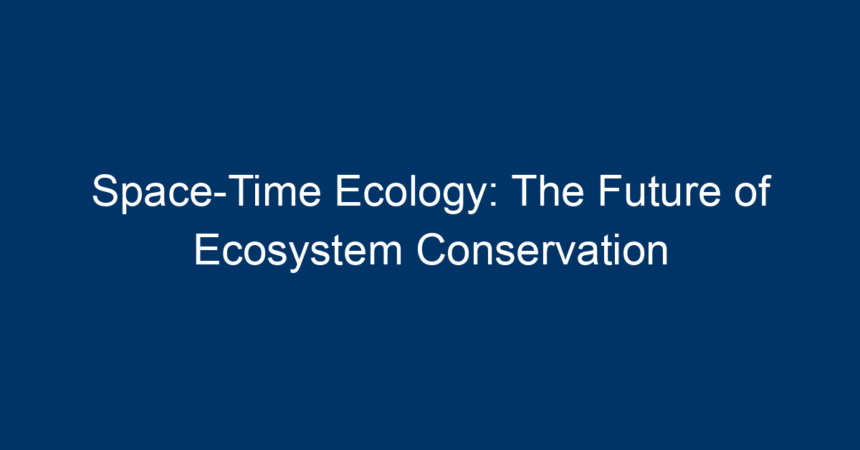In an age where environmental challenges loom large, innovative approaches to ecosystem conservation are more crucial than ever. Traditional conservation methods, while effective to some extent, often fail to account for the complexities and dynamics of ecosystems over time and space. Enter space-time ecology, a cutting-edge framework that intertwines ecological data with geographical and temporal variations to address conservation needs in a holistic manner. This article delves into the meaning of space-time ecology, its significance in ecosystem conservation, and how it can pave the way for a more sustainable future.
Understanding Space-Time Ecology
What is Space-Time Ecology?
Space-time ecology is an interdisciplinary approach that combines ecology with the spatial and temporal dimensions of life. It considers how interactions among species, their environments, and human activities change across different scales—both geographically and temporally. This framework is built on the understanding that ecosystems do not exist in isolation; they are dynamic entities influenced by various factors such as climate change, human interventions, and biological interactions.
The Importance of a Multiscale Approach
Conservation efforts often focus on single species or localized areas, which can overlook broader ecological patterns. Space-time ecology allows researchers and conservationists to evaluate ecosystems from multiple perspectives, recognizing that changes in one area can have ripple effects throughout the ecosystem. By integrating data across different time frames—daily, seasonally, and annually—conservation practices can become more adaptable and responsive to changes, from immediate ecological shifts to long-term climate evolution.
The Role of Space-Time Ecology in Ecosystem Conservation
Mapping Ecosystem Dynamics
One of the most significant contributions of space-time ecology is its ability to provide a comprehensive map of ecosystem dynamics. By utilizing Geographic Information Systems (GIS) and remote sensing technologies, researchers can visualize and analyze how ecosystems change over time and space. This spatial data offers insights into patterns of biodiversity, habitat loss, and resource availability.
Predictive Modeling for Conservation Planning
Using predictive modeling is another area where space-time ecology excels. By analyzing historical data and current trends, conservationists can forecast how ecosystems might respond to future changes. This foresight enables proactive conservation strategies, allowing for the protection of vulnerable species and habitats before they reach critical thresholds.
Enhancing Resilience Through Adaptive Management
The principles of space-time ecology advocate for adaptive management practices. As ecosystems fluctuate due to climate events or human activity, adaptive management allows conservation strategies to evolve in real-time. This flexibility is vital for enhancing ecosystem resilience, as it equips stakeholders with the tools necessary to respond effectively to changing conditions.
Case Studies in Space-Time Ecology
Coral Reef Conservation
One poignant example of space-time ecology in action is the conservation of coral reefs. These ecosystems are highly sensitive to changes in water temperature, salinity, and human impact. By applying space-time ecology, researchers can monitor coral health over various spatial scales, predicting bleaching events and identifying areas in need of immediate protection. This informed approach has promoted the establishment of marine protected areas (MPAs) that are strategically located to support reef resilience.
Forest Ecosystems and Fragmentation
Another pertinent case is the conservation of fragmented forest ecosystems. Through the lens of space-time ecology, researchers have studied how forest patches interact over decades, examining species migration patterns and genetic diversity. This understanding has led to the creation of wildlife corridors that enhance connectivity among habitats, thereby promoting biodiversity and ecosystem health.
Challenges in Implementing Space-Time Ecology
Data Limitations
While the advantages of space-time ecology are clear, the implementation comes with challenges. One primary hurdle is the availability and quality of data. Many regions worldwide lack comprehensive ecological data, making it difficult to apply space-time models effectively. Continuous efforts should be invested in data collection, archiving, and sharing to build robust ecological databases.
Integrating Varied Stakeholder Perspectives
Adapting space-time ecology principles often requires collaboration among a diverse group of stakeholders, including government agencies, nonprofits, and local communities. This diversity can sometimes lead to conflicting interests and perspectives. Facilitating effective communication and cooperation among these groups is essential for successful conservation initiatives.
Actionable Insights for Conservationists
Embrace Technology
Conservationists should leverage technology, such as GIS and remote sensing, to collect and analyze ecological data. By staying up-to-date with advancements in these fields, they can enhance their understanding of ecosystems and make better-informed decisions.
Foster Local Engagement
Engaging local communities in conservation efforts is crucial. Their insights and traditional ecological knowledge can significantly enrich conservation strategies based on space-time ecology. Additionally, involving locals helps in creating a sense of ownership over conservation programs, leading to more effective outcomes.
Advocate for Policy Changes
Policymakers should be educated on the importance of space-time ecology in shaping conservation strategies. By advocating for policies that support adaptive management and prioritize long-term ecological health, conservationists can help ensure that future generations inherit a flourishing natural world.
Conclusion: The Path Forward
Space-time ecology represents a transformative approach to ecosystem conservation, breaking away from traditional frameworks that often fail to capture the complexities of life on Earth. By embracing this multidimensional perspective, conservationists can develop strategies that are not only effective in the short term but also resilient in the face of ongoing environmental changes.
As we look to the future, the call to action is clear: we must invest in education, technology, and community engagement to harness the full potential of space-time ecology. By doing so, we can ensure that our ecosystems thrive for generations to come, safeguarding the delicate balance of life on our planet.
In this journey towards sustainable conservation, every individual has a role to play—from policymakers to local communities to ecologists. Together, we can shape a future where ecosystems are preserved, biodiversity flourishes, and humanity coexists harmoniously with nature. Embracing space-time ecology is not just a strategy; it is a critical step towards a sustainable planet.




